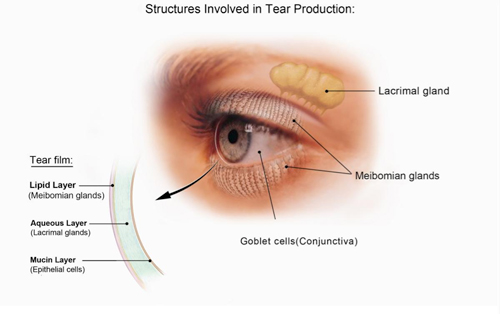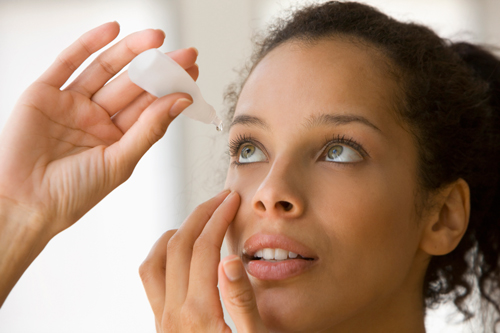By Linda Hardy, LDO- GA, CPOT, COA
In most places, winter is almost always cold and windy. The heaters are running full blast. This can drastically drop the humidity level in your home and vehicle, which can cause eyes to dry out quickly. Dry eyes can lead to discomfort, pain, itching, light sensitivity, blurred vision, and excessive tearing. With so many complications, it is worthwhile to discuss possible dry eye issues with all patients, especially contact lens wearers.
As we heat our homes and cars, the humidity level can drop up to 50 %. This can cause your eyes to dry out more quickly than they can produce good tears. Tears are made up of three layers: Mucin, oil (lipid), and water (aqueous), which make up the tear film. The tear film protects and lubricates the eyes, reduces the risk of eye infection, washes away foreign bodies, and keeps the cornea smooth and clear. If these layers become unbalanced, dry eyes occur.

Image courtesy of National Eye Institute “Facts About Dry Eye”
Pre-treatment for dry eyes is a must. Using over the counter artificial tears at least two to four times a day can help. Systane, Refresh, and Blink all work very well and do not cause blurred vision. For those patients who need more lubrication, non- preserved drops would be an appropriate option. These are packaged as single-vials. Non-preserved drops can be used several times a day without concern for corneal neurotoxicity. If symptoms of dryness continue, lubricant gels are a good choice, but can cause blurred vision. These gels are best used at bedtime.

If over the counter medications don’t help, or become an inconvenience, there are prescription options. Restasis, a cyclosporine emulsion, is a well-known dry eye treatment. Cyclosporine drugs can increase tear production that has been reduced by inflammation. Xiidra is a newer drug which is a lifitegrast ophthalmic solution. Lifitegrast reduces inflammation by inhibiting inflammatory cell binding. Both drugs work very well, but take time to show effectiveness, and are costly.
Contact lens wearers may have an even harder time with eye dryness during the winter. Using lubrication drops for contacts is important, and patients may need to cut back on the amount of time contacts are worn during a day. Daily disposable contacts are always a good option during this time of year. Dailies tend to be thin, wet well, and you have a new pair every day. That way, if the lens does get dry by the end of a day, just toss it out. There may be severe cases that require contacts to be discontinued until the humidity in the environment improves.
Educating patients is important, too. Prepare them for possible issues, and give them the skills to help treat dryness. Contact your drug representatives to get samples and coupons. Even the over the counter drops can be pricy, especially with how frequently they will be used. Educating your patients not only helps them have a comfortable, clear winter season, it may lessen the chair time your doctors have treating common winter chief complaints.













